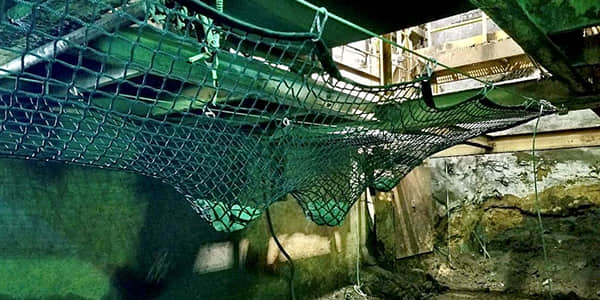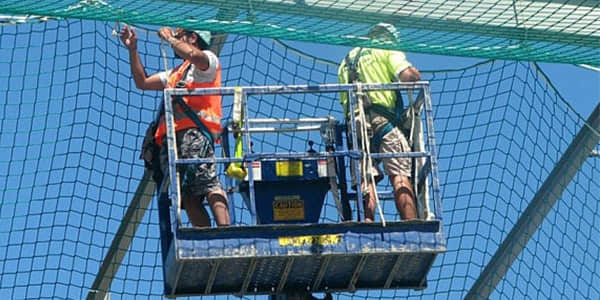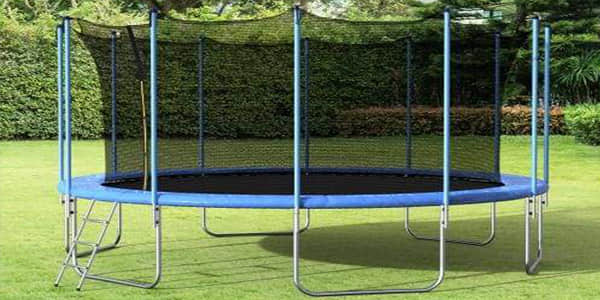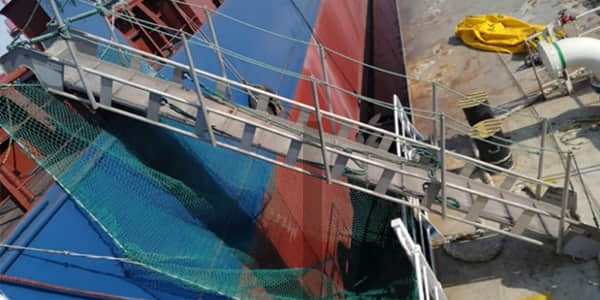Load capacity refers to the allowable weight or impact force that a safety net can bear when used and will not be broken or damaged. To ensure the safety of construction, stations and various occasions for aerial work. The load capacity of the safety net plays a very important role in protecting the personal safety of workers and avoiding the loss of the site. Safety aspects are becoming more and more strict. Therefore, it is particularly important to know the factors that affect the load capacity of the safety net and the application occasions where the load capacity is small or large. So, today we will explain in detail the core concept of the load capacity of the safety net to help you guide the choice to achieve the use effect in the safety protection of the working environment, and also some questions worth considering.
Aspects That Affect The Load Capacity Of Safety Nets
The load capacity of a safety net is influenced by a number of factors; it is important to consider those factors before choosing a safety net. Some of the most important factors are:
• Material type: The load capacity will depend upon the material type chosen for manufacturing the net; high-strength fibers such as nylon and polyester can improve strength and durability.
• Design structure: The mesh size, weave pattern, and strength of the node s will influence the dispersion of the impact and the overall strength of the safety net.
• Installation method: Correct and proper installation, will help ensure that the safety net should be tightened up and local excessive stretch is avoided.
• Environmental Conditions: Extreme temperatures, high humidity, and exposure to UV will affect properties and descne affect load capacity..
• Time and Aging: Materials may deteriorate over extended periods of time; the material age is an important consideration that can affect the load capacity.
Safety Net Load Capacity In Different Application Scenarios
The load capacity of safety nets has its own unique requirements and standards in different application scenarios. Depending on the use environment and purpose, the design and load capacity of safety nets will vary to ensure the most effective protection in specific situations. The following are several common application scenarios and their requirements for the load capacity of safety nets:
Construction Site
- On construction sites, safety nets are mainly used to prevent falling objects and protect workers. Due to the complex environment of the construction site and the heavy weight of the falling objects, the safety nets must have a high load capacity, usually hundreds of kilograms. Safety nets on construction sites should comply with strict industry standards, such as EN 1263-1, to ensure that they can effectively support falling tools, construction materials and even workers themselves.

Sports Venues
- In sports stadiums, the main function of safety nets is to prevent high-speed balls or equipment from flying out of the stadium, protecting spectators or equipment from injury. Since the impact force in such scenarios mainly comes from high-speed objects such as footballs, baseballs or ice hockey pucks, safety nets need to have high impact resistance and relatively low load capacity. Usually, the design of such safety nets focuses more on flexibility and durability to withstand frequent impacts without being easily damaged.

Industrial Scenes
- In industrial scenarios, safety nets are often used to catch falling equipment, tools, or prevent people from falling. In this case, the load capacity requirement is high, especially in environments such as factory workshops and warehouses, where the falling objects may be very heavy, so the safety net must be able to withstand considerable impact. Safety nets in some heavy industrial scenarios even need to meet more stringent standards to ensure safety.

Working At Heights
- In aerial work scenarios, the main purpose of safety nets is to prevent people from falling, so load capacity is a crucial factor. Such safety nets are usually required to have very high tensile strength and load capacity to ensure that they can withstand the weight of one or more workers and the tools or equipment they carry. Safety nets also need to consider the size of the mesh to prevent small objects such as tools from falling, and need to comply with international standards such as ISO 1806 to ensure that they can effectively protect in emergency situations.

Outdoor Activities And Events
- In outdoor activities such as rock climbing, skiing or rope challenges, the load capacity of the safety net is mainly for personal safety protection. The safety net for such activities needs to be flexible and lightweight, but still needs to be able to withstand a certain weight and impact, especially when participants fall unexpectedly. In this case, although the load capacity of the safety net is not as high as that required in construction sites or industrial environments, it still needs to ensure sufficient strength to cope with the impact of the human body.

Ships And Marine Operations
- To protect personnel in addition to the use of safety nets these needs to take humidity environments, and corrosion into consideration. These safety nets must be highly corrosion resistant, highly UV resistant, and additionally have sufficient load capacity as to be able to act as intended in the harsh environment demonstrated at sea potentially encountering stress and impacts.

Methods To Enhance The Load Capacity Of The Safety Net
The safety net's load capacity is essential to its functioning. The load capacity will be dictated by the specific application, but load capacity can usually be optimized through material selection and inspection, maintenance, installation, and innovation. Below are some methods to increase the load capacity and ultimate service life of a safety net.
High-Quality Material Selection
- Select high-strength fiber materials such as nylon, polyester or HDPE. These high-strength fibers help improve stretch resistance and durability to other impacting conditions. Also look for UV-resistance and corrosion-resistant materials to meet international loading capacity compliance (e.g. ISO 1806, EN 1263-1).
Optimized Design And Structure
- Mesh size and node strength directly affect load capacity. Small mesh can evenly disperse stress, strengthen the connection strength of edges and nodes, and improve overall tensile strength through high-strength weaving technology.
Correct Installation Method
- Incorrect installation will affect the load capacity. Ensure sufficient tension and support during installation, especially in high-altitude operations. A professional team should set up sufficient fixing points and check them regularly.
Regular Inspection And Maintenance
- Over time, safety nets may age and wear out. Regularly check the condition of the material to ensure that the nodes and connections are intact. If any problems are found, they should be repaired or replaced immediately.
Avoid Excessive Use And Overloading
- Safety nets have their designed maximum load capacity. Avoid overloading and regularly evaluate usage scenarios to ensure that they meet design requirements.
Modern
- manufacturing techniques such as new weaving methods and synthetic materials can improve the impact resistance of safety nets. New materials such as Kevlar fiber further increase the load capacity.
Regular Testing And Certification
- Regular tensile testing is carried out to check whether the safety net meets the design standards and issue a certification report. Make sure the safety net you purchase is certified by a third party and meets the relevant standards.
Safety Net Regulations And Standards
When it comes to selecting and employing safety nets, compliance with regulations and standards is imperative. These standards govern the design, materials, and load capacity of safety nets to ensure the efficient and effective use of safety nets for the intended purpose. Key regulations include:
- ISO 1806: This is a universal standard for testing tensile strength ensuring the structural integrity of a safety net upon impact. ISO 1806 is applicable for construction use, in industry use and in sports stadium use.
- EN 1263-1: EU standard that specifies the materials, mesh size and load capacity of aerial work safety nets to ensure that the safety nets can withstand the specified loads in actual applications.
- OSHA Standards: U.S. Occupational Safety and Health Administration standards that ensure safety nets can withstand the kinetic energy of falling workers and tools, and require regular inspections and maintenance.
- ANSI A10.11: The U.S. building safety net standard requires that the safety net withstand an impact force of at least 5,000 pounds and conducts detailed testing on the use of the safety net.
- Other regional standards: such as Japan's JIS standards and Australia's AS/NZS standards, adapted to local climate and safety needs, ensuring that safety net design and performance comply with local regulations.
- Safety net certification: Qualified safety nets must be certified by a third party, such as CE certification, to indicate their load capacity and performance information.
- Load capacity guide: Regulations require safety nets in different application scenarios to have specific load capacities. It is recommended to choose products that exceed the minimum standards to enhance safety.
Summarize
The load capacity of a safety net is the core factor that determines whether it can effectively provide safety protection. By selecting high-strength materials, optimizing the design structure, correct installation, regular maintenance and complying with relevant regulations and standards, it can be ensured that the safety net has sufficient load-bearing capacity in various application scenarios.
Whether it is a construction site, industrial site, sports stadium or other high-risk environment, understanding and mastering the calculation method of the load capacity of the safety net and strictly following the standards are the basis for ensuring the safety of life and property. Regularly testing and certifying the performance of the safety net and selecting the right product according to specific needs can provide higher safety protection in the workplace.
FAQ
How often do safety nets need to be inspected?
- It is recommended to inspect safety nets regularly, especially in high-risk locations such as construction sites or industrial scenarios. Generally, a comprehensive inspection should be carried out immediately after each period of use or after a major impact. If aging, wear or damage is found, it should be replaced or repaired in a timely manner.
What role does the safety factor play in the calculation of safety nets?
- The safety factor is used to ensure that the safety net still has sufficient safety margin under extreme conditions. Usually, a safety factor of 2 to 5 is introduced into the load capacity calculation to compensate for factors such as material defects, installation errors and environmental influences to ensure that it will not fail due to overload during use.
Will the load capacity of safety nets change over time?
- Yes. Over time, when exposed to environmental factors such as ultraviolet rays, moisture, chemicals, etc., the safety net material will gradually age and the load capacity will decrease. Therefore, regular inspection and maintenance of safety nets is key to maintaining their load capacity.





